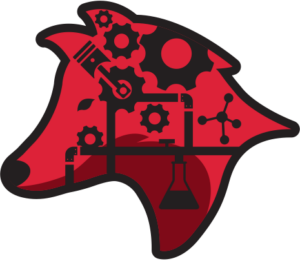Making Automated Chemistry Intuitive: Worker-Centered Automation and AI!
Part of the joy of chemistry is making new forms of matter with your own hands. Unfortunately, those manual procedures can be hard to reproduce without a lot of specialized training. Imagine wanting a compound and with one click having the code to build an automated setup from a handful of standard parts? And then that code precisely controls all the moving parts, too!
The Pohl Lab has been working since the early 2000s to develop such human-centered protocols and chemistries that are fully described for easy reproducibility. We want human creativity and ethics to lead the dance with computer-driven machines. Our custom built code is based on Python and is called MechWolf. Benjamin Lee and Alex Majelis developed it with Prof. Pohl when she was a Fellow of the Radcliffe Institute at Harvard in 2017-2018). The word MechWolf looks like flowchem, but the code can also be used to set up batch reactions and so much more. It is set up to not only turn on pumps and switch valves—the classic components of automated synthesis platforms—but also to describe exactly how to assemble modular parts to build the exact setup in your own lab. Everything is easy enough for a cheap little Raspberry Pi microcomputer to link up to your HPLC, syringe, or other pumps and other active components to have your own automated synthesizer. We usually use Jupyter Notebooks as a user-friendly way of including not just the code, but enough human-friendly text to make getting started easy. Now every lab member has their own automated synthesizers in their fume hood.
We now are building maps of organic compounds with directions (the code!) to get you to any destination. The gorgeous chemical structure of each destination has its own InChI Key to easily find it with a text search. For simplicity for human readers, structures use common abbreviations, such as Bn for the benzyl group and Ac for acetate. Click on the arrow and you get to the procedure!

Contact Prof. Pohl if you want to join others who have visited the lab to automate their own chemistry. Here are some resources to get you started!
Automated Chemistry (in Batch and Flow) Resources

Flow Parts Inventory 12-12-2023PohlLab
Publications To Start
• How to start thinking about converting all those old manual reactions into new automated ones!
Saliba, R. C.; Wooke, Z. J.; Nieves, G. A.; Chu A.-H. A.; Bennett, C. S.*; Pohl, N. L. B.* (*joint corresponding authors) Challenges in the conversation of manual processes to machine-assisted syntheses: Activation of thioglycosides donors with aryl(trifluoroethyl)iodonium triflimide. Org. Lett. 2018, 20, 800. DOI: 10.1021/acs.orglett.7b03940
• See how we use MechWolf for the first automated building block syntheses
(We hosted a Tufts grad student in Bloomington to learn the ropes and that was the start of a great collaboration!): Yalamanchili, S.; Nguyen, T.V.; Zsikla, A.; Stamper, G.; DeYong, A. E.; Florek, J.; Vasquez, O.; Pohl, N. L. B.*; Bennett, C. S.* Automated, multistep continuous-flow synthesis of 2,6-dideoxy and 3-amino-2,3,6-trideoxy monosaccharide building blocks. Angew. Chem. Int. Ed. 2021, 60, 23171-23175. DOI: 10.1002/anie.202109887
• A great background for how to start thinking about designing your own carbohydrate building blocks
DeYong, A.; Rudich, Meredith L.; Pohl, Nicola L. B. Synthesis of Carbohydrate Building Blocks for Automated Oligosaccharide Synthesis. Reference Module in Chemistry, Molecular Sciences and Chemical Engineering, Comprehensive Glycosciences, 2nd edition, Elsevier, 2021, ISBN-13: 9780128194571. DOI: 10.1016/B978-0-12-819475-1.00109-7.
